5th Order Rainbow Discovery Image - OPOD
Exploring the 5th Order Rainbow Discovery Image
Rainbows have captivated our attention since ancient times, with the primary and secondary rainbows being well-known phenomena. However, it wasn't until 2011 that the elusive 3rd and 4th order rainbows were finally captured in images. And now, we have the privilege of witnessing the discovery of the 5th order rainbow.
On August 8, 2012, Harald Edens photographed the first-ever image positively identifying the 5th order rainbow. Located between the primary and secondary rainbows, this quinary rainbow is formed by sunlight reflecting five times inside raindrops. In Harald's image, we can observe its broad greens, which tend to shift towards blue near the primary bow. Unfortunately, the yellows and reds of the 5th order rainbow are hidden behind the secondary bow.
Harald's success in capturing this rare phenomenon can be attributed to several factors. Firstly, he took the photograph from the Langmuir Laboratory for atmospheric research near the summit of South Baldy Peak, New Mexico, where the air is exceptionally clear and of low density due to the high altitude. Additionally, he benefited from the presence of small thunderstorms that produced bright rainbows locally. Years of astute observation as an atmospheric optics expert also played a crucial role in his achievement.
The 5th order rainbow is not alone in its existence. It overlaps with the 6th order rainbow, both of which extend into Alexander's dark band—the dark region of sky between the primary and secondary rainbows. Interestingly, the greens and blues of the 5th order rainbow can be observed within this dark band. The tertiary rainbow, formed by three internal reflections, adds to the intricate beauty of these optical phenomena.
As we ascend through the rainbow orders, each successive higher order becomes fainter and broader than its predecessors. This is due to the increasing number of reflections within raindrops, which gradually disperse the colors and broaden the appearance of the bow. Consequently, observing higher-order rainbows becomes more challenging as their faintness increases. However, the dark sky between the primary and secondary rainbows provides a fortuitous opportunity to catch a glimpse of at least part of the 5th order rainbow.
What lies beyond the 5th order? The 6th order is often obscured by the light inside the primary bow, making it difficult to observe. However, with continued advancements in imaging techniques and atmospheric optics research, the discovery of the 7th order rainbow may not be far off.
In February 2015, Harald's comprehensive observations, analysis, discussion, and conclusions regarding the 5th order rainbow were published in a scientific paper titled 'Photographic observation of a natural fifth-order rainbow' in Applied Optics. This publication further solidifies the significance of his groundbreaking discovery.
To gain a deeper understanding of the 5th order rainbow and its visibility, ray tracing calculations have been conducted. These simulations reveal how the higher orders of the rainbow become progressively fainter. By filtering out the primary and secondary bows, we can better perceive the far fainter higher-order rainbows.
Harald's dedication to documenting atmospheric phenomena extends beyond his initial discovery. After identifying the 5th order rainbow, he delved into his extensive image collection and continued capturing post-discovery pictures. These images provide further evidence of the presence of the 5th order bow, as traces of it can be observed even in previously taken photographs.
In conclusion, the discovery of the 5th order rainbow is a testament to both human curiosity and the beauty of nature. It serves as a reminder that there is still much to explore and understand about atmospheric optics. With ongoing research and advancements in technology, we may soon uncover even more intricate and awe-inspiring optical phenomena hidden within rainbows.

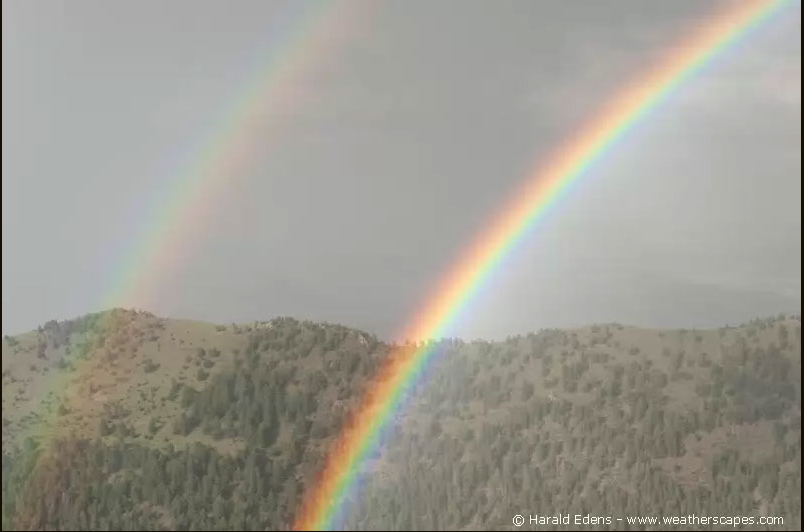
5th Order Rainbow Discovery Image
The familiar primary and secondary rainbows have been known since there were eyes. The long sought 3rd and 4th order rainbows were finally imaged in 2011. Now we have the 5th order.
Harald Edens photographed it on August 8, 2012. This is the first ever image on which the 5th order rainbow is positively identified. The version at left is considerably enhanced. Mouse over it to compare it with Harald's RAW camera image.
The primary rainbow is at right. At far left is the outer secondary rainbow seen during strong showers when the primary is particularly intense. Between them is an area of dark sky, Alexanders dark band, where there is no primary or secondary rainbow light.
There lies part of the fabled quinary or 5th order rainbow made by sunlight reflected five times inside raindrops. We see only its broad greens tending to blue towards the primary bow. Its yellows and reds are hidden behind the secondary bow.
Harald took this from the Langmuir Laboratory for atmospheric research near the 10,800ft summit of South Baldy Peak, New Mexico, USA.
Harald has now photographed the 5th order several times. He ascribes his success to the very bright rainbows formed locally from small thunderstorms and to the exceptionally clear high altitude low density air. Astute observation over many years by an atmospheric optics expert also helps somewhat! All images ©Harald Edens, shown with permission
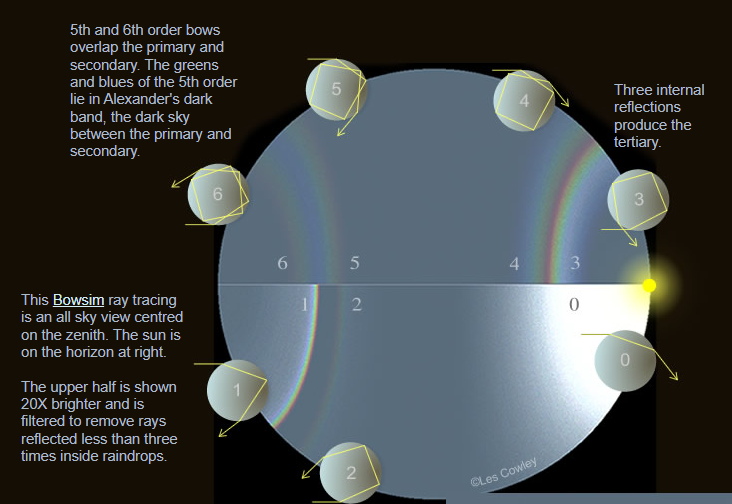
5th and 6th order bows overlap the primary and secondary. The greens and blues of the 5th order lie in Alexander's dark band, the dark sky between the primary and secondary.
Three internal reflections produce the tertiary.
This Bowsim ray tracing is an all sky view centred on the zenith. The sun is on the horizon at right.
The upper half is shown 20X brighter and is filtered to remove rays reflected less than three times inside raindrops.
The primary rainbow is produced by sunlight reflected once inside raindrops. Its outer red edge forms a circle ~42° radius centred on the antisolar point directly opposite the sun. The secondary bow from two internal reflections surrounds it. The 3rd and 4th order bows are towards the sun and since their discovery have now been photographed several times.
Each successive higher order is fainter and broader than the lower ones. The increasing number of reflections take their toll. Rays forming higher orders skim ever closer to the drops' edge where the increasing angle of incidence produces greater and greater colour dispersion, thus broadening the bow.
As the rainbow order increases, its observation gets more and more difficult. But, the dark sky between the primary and secondary presents a wonderful opportunity to see at least part of the 5th order rainbow fortuitously placed there.
What next? The 6th order is lost in the light inside the primary bow. The 7th order could be next!

Scientific Publication
Harald's observations, analysis, discussion and conclusions will be fully published in February 2015:
Harald E Edens
'Photographic observation of a natural fifth-order rainbow'
Applied Optics, Vol. 54, Iss. 4, pp. B26–B34 (2015)
A ray tracing calculation looking away from the sun.
The view at right filters out the primary and secondary bows to reveal the far fainter higher orders.
Below: An unfiltered simulation showing how the firth order is partly visible. Compare it with Harald's image.

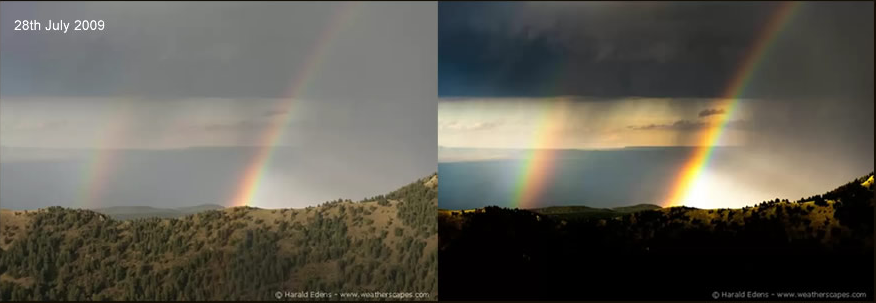
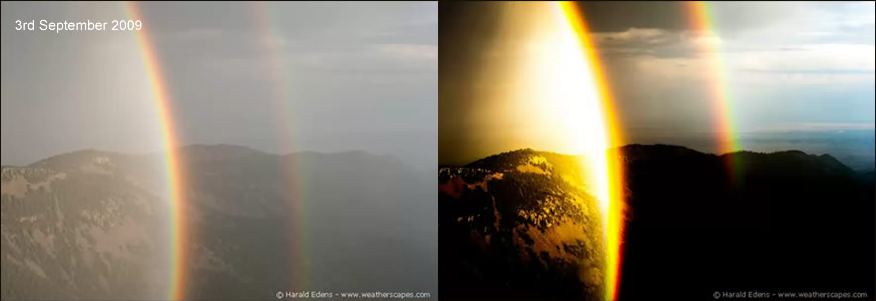
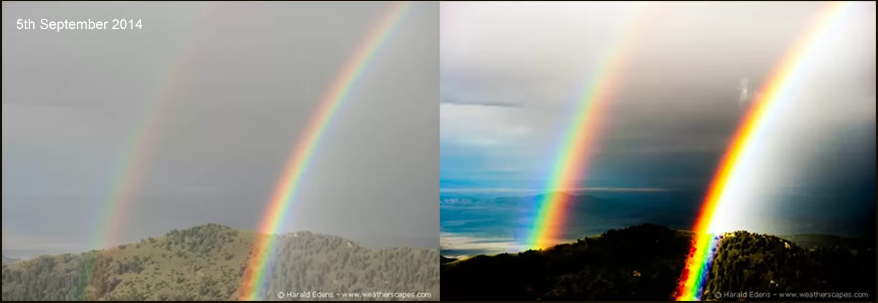
Before & After
After his discovery, Harald searched back through his extensive image collection and also took post discovery pictures.
Here are some examples showing traces of the 5th order bow. More are here.
The RAW camera image is at left.
The processing of the versions on the right is black and white point adjustment and then contrast, and exposure compensation. No increased colour saturation is needed. Adobe Lightroom 5.6 was used.









Note: this article has been automatically converted from the old site and may not appear as intended. You can find the original article here.
Reference Atmospheric Optics
If you use any of the definitions, information, or data presented on Atmospheric Optics, please copy the link or reference below to properly credit us as the reference source. Thank you!
-
<a href="https://atoptics.co.uk/blog/5th-order-rainbow-discovery-image-opod/">5th Order Rainbow Discovery Image - OPOD</a>
-
"5th Order Rainbow Discovery Image - OPOD". Atmospheric Optics. Accessed on December 22, 2024. https://atoptics.co.uk/blog/5th-order-rainbow-discovery-image-opod/.
-
"5th Order Rainbow Discovery Image - OPOD". Atmospheric Optics, https://atoptics.co.uk/blog/5th-order-rainbow-discovery-image-opod/. Accessed 22 December, 2024
-
5th Order Rainbow Discovery Image - OPOD. Atmospheric Optics. Retrieved from https://atoptics.co.uk/blog/5th-order-rainbow-discovery-image-opod/.